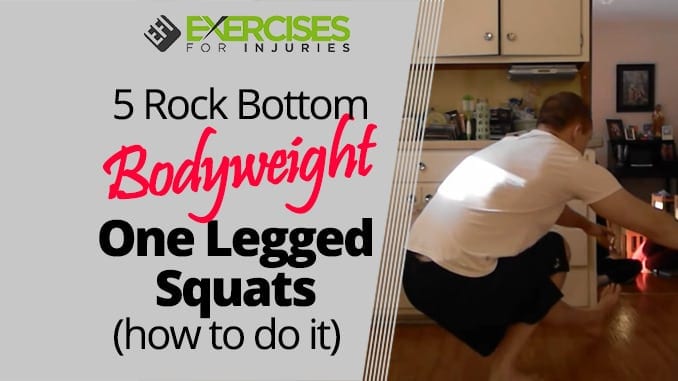A Rock Bottom Bodyweight One-Legged Squat is a single leg squat performed with your back foot on a bench or chair.
I hope you had a great Easter.
My family and I had a great time in Disneyland looking for the Easter Bunny on one of the trail rides.
Looking at yesterday’s rides, the Tower of Terror was the best.
Today I have my friend Sean Schniederjan, who will teach you the inner workings of the one-legged squat over the next few days.
Take it away, Sean.
If you are a man or woman, big or small, interested in health and strength and teaching others to do the same, you need to be able to do at least five rock bottom, clean, under control one-legged squats.
Your imagination might be telling you this is “hardcore.” It isn’t.
What is a Rock Bottom Bodyweight One-Legged Squat?
The one-legged squat is a challenging exercise that requires a lot of balance and coordination. This places a huge demand on your quadriceps, glutes, hips, back, and core. Perform a Rock Bottom Bodyweight One-Legged Squat with your back foot on a bench or chair, and you’ll discover why this is considered one of the most difficult variations of the squat. It will improve your overall body strength and help to prevent injury. With improved muscle strength and flexibility, you’ll notice improvements in your everyday life and sports performance.
The bodyweight one-legged squat is about one thing: precision.
Precise ankle mobility. Precise hip mobility and stability. Balance and control over your lower body and core. Precise muscle patterning. The ability to maintain strength under the demands of above-average flexibility and mobility simultaneously.
You can’t have tight ankles or hips and do a bodyweight one-legged squat. And you can do a weighted one to compensate for poor mechanics, but not a pure bodyweight “pistol.”
You might say that it takes strength and mobility that most people don’t have.
Wrong.
I couldn’t do it for years, but it was easy after learning a few “tricks.”
I don’t know how to sugarcoat this: you can’t be weak and do a one-legged squat. You can do squat thrusters and mountain climbers with everyone else, but not “la Pistola,” as they call them, in the mountains outside Spain.
How much strength do you need?
I did the math, and a BW one-legged squat is equivalent to whatever two-legged squat you please – with 70% of your body weight.
So if you weigh 200 pounds, a one-legged squat is approximately the same as front squatting two 70-pound kettlebells, for example, in terms of load per leg.
That isn’t off the charts strong by any means, but it tells us that you can get into the “heavy” neighborhood without relying on equipment. Donnie Thompson, a mountain man who squats over 1000 pounds, does his double KB front squats with two 88 pounds (40 kg) bells – so we are in the neighborhood.
If you ever find yourself without a squat rack or some kettlebells, you have the freedom to strengthen your legs.
So go ahead and try it to establish a baseline. Let’s do this. Stick one leg out and descend slowly, butt to heel, and come back up.
If you want to turn your leg to jello quickly, go real slow like this:
Don’t worry if you have failed. I used to be in the same boat. It isn’t easy.
I once heard a trainer who worked with a professional football team say that it would take 15 minutes to teach this move to professional football players, some of the best athletes.
There are two parts to this puzzle: mobility and strength.
Start with fine-tuning your hip and ankle mobility.
Trying to get strong with poor joint mechanics and tight muscles is stupid, or at the very least, not very smart. We use engineers to design buildings and bridges to withstand heavy loads; we should do the same with our bodies if we choose to push them beyond mediocrity.
The “mobility minimum” of a one-legged squat is the ability to do a close stance squat. This is where your two feet are touching.
So bring your feet together, touching, and go butt to heel into a squat. Having trouble?
Don’t worry.
Tomorrow you’ll get a FREE video with four simple and easy exercises (bring a light-medium kettlebell) that will improve your hip and ankle mobility for a close stance squat and eventually a bodyweight one-legged squat.
I can’t wait to help you instantly improve your mobility tomorrow.
Sean Schniederjan, RKC
PS: If you or your clients have tight hips or ankles, do not miss the free, exclusive video tomorrow.

